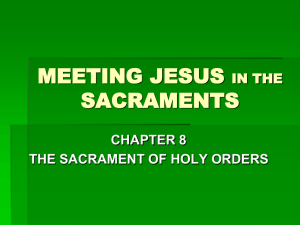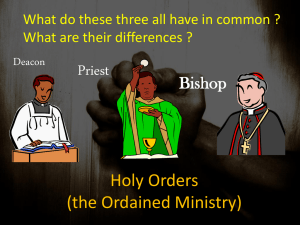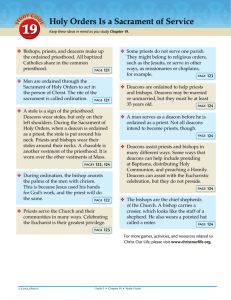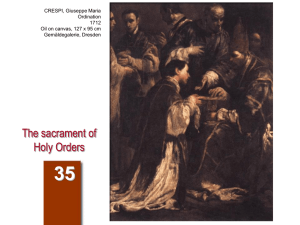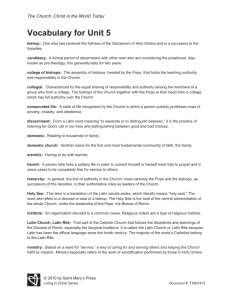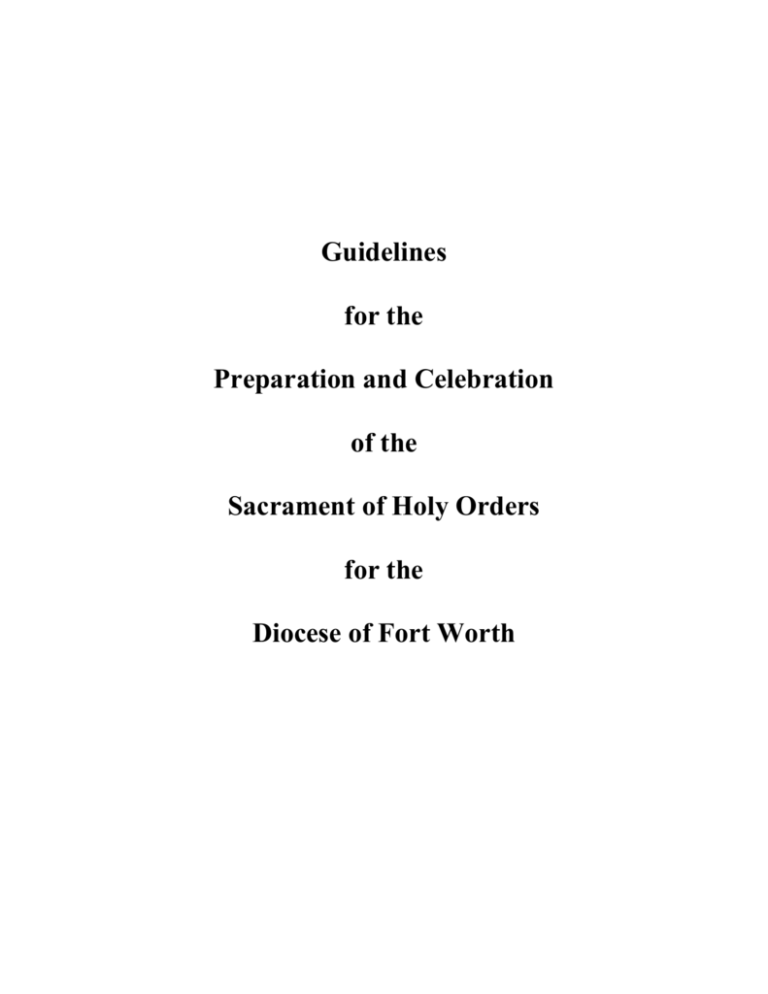
Guidelines
for the
Preparation and Celebration
of the
Sacrament of Holy Orders
for the
Diocese of Fort Worth
The Sacrament of Holy Orders
Table of Contents
DOCTRINAL OVERVIEW
1
HISTORICAL SUMMARY OF THE SACRAMENT OF HOLY ORDERS .......................................................... 1
THEOLOGY OF THE SACRAMENT OF HOLY ORDERS AND CORRELATION WITH THE CATECHISM OF
THE CATHOLIC CHURCH .............................................................................................................................. 3
GUIDELINES FOR THE PREPARATION AND CELEBRATION OF THE
SACRAMENT OF HOLY ORDERS
Note: Because both preparation of candidates for Holy Orders and celebration of the sacrament
are uniquely the responsibility of the Diocesan bishop and his staff; and because these
responsibilities are so closely regulated by both national and universal norms, the diocesan
guidelines will give only a doctrinal overview.
For further information about preparation of candidates and celebration of the sacrament,
contact the Diocesan Office of Vocations and the Diocesan Office for Permanent Diaconate.
I.
Doctrinal Overview
A. HISTORICAL SUMMARY OF THE SACRAMENT OF HOLY ORDERS
1. Summary to 100 A. D.
a. Only one priest – Jesus Christ; his ministry, service.
b. All believers share Christ’s ministry
c. Ordained priest – a special sign of Christ’s priesthood and a call to serve all Believers
in living out Jesus’ ministry.
d. First priestly leaders (Bishops) recognized by their outstanding service and guided
community in learning Jesus’ teachings, doing good works and celebrating the
Eucharist.
e. At first there were different types of Church government but before too long the
monarchical form – as for a king – prevailed.
f. Bishop looked to talents of other Christian men and women – preaching, teaching,
healing, and prophesying – to help him in his ministry.
g. Two groups became recognized assistants: Priests to act as advisors, deacons to work
with the daily needs of the people.
2. Summary: Second to Sixth Centuries
a. All the individual tasks of ministry had an ordination rite to give “authority” for the
job.
b. Authority within the whole Church was by “collegiality,” mutual consultation and
renewal.
Holy Order
1
c. Bishops delegated power to priests so they could minister to the growing number of
churches.
d. Priest’s role as “Vicar of Christ” carried idea of special spiritual power.
e. Clergy gained further power by acting as judges and counselors in government.
f. Power-authority tended to overshadow as priestly ministry.
3. Summary: Sixth to Sixteenth Centuries
a. Monastic life influenced priesthood
1) Separateness of clergy emphasized in tonsure and special clothing
2) Celibacy for all priests
3) A life of prayer and spirituality separate from everyday world.
b. Middle ages and Renaissance saw priesthood as one of several levels of power.
Bishops, not priests, had power to confirm and ordain.
c. Clergy took over total responsibility for worship and devotion – no role for people.
d. Priests tended to form an elite class with political and church power.
e. Council of Trent tried to limit Bishops’ power and to insure better education for
priests.
4. Seventeen and eighteenth centuries the aspect of secular and political power in the
priesthood began to disappear. The clergy became pastors, “sacristy” priests, caring for
the church and ceremonies of worship, holding office hours in the sacristy, and seldom
leaving the confines of the church except to visit the sick. The continued to be
“separated” men, held to be wise in the ways of God, but sharing little with the lives of
the people.
5. Nineteenth Century to Vatican II
a. With the resources of the Vatican library at hand, scholars begin to examine the
history and development of the priesthood.
b. Catholic theologians began to examine the signs of Christ’s priesthood in their own
ministries and those of other faiths.
c. In 1962, the Bishops at Vatican II commissioned new rites of ordination that talk of
sharing and service rather than authority and power. Like the early Church leaders,
Holy Order
2
they begin working things out in collegiality.
Adapted from The Changing Sacraments. Reprinted by permission of St. Anthony Messenger Press, 1615 Republic Street,
Cincinnati, Ohio 45210. All rights reserved
6. Vatican II to the present.
a. Vatican II’s renewal of Church traditions affirms the role of Bishop as fullness of
priesthood.
b. The relationship of priests to their bishop in a spirit of collegiality is emphasized.
c. The office of deacon is restored as a permanent order in the Church’s sacramental
ministry.
d. Restoration of the essential place of Scripture in the life and worship of the Church
brings about a new emphasis on the role of preaching in the life and ministry of all
ordained ministers.
e. The Council’s vision of the Church as the People of God infuses its understanding of
ordained ministry with a more communitarian spirit. Clergy become more free to
utilize the talents and experience of laity in the exercise of their ministry of leadership
and service.
B. THEOLOGY OF THE SACRAMENT OF HOLY ORDERS AND CORRELATION
WITH THE CATECHISM OF THE CATHOLIC CHURCH
1. The source of all ministry in the Church is the priestly, prophetic, and royal
ministry of Christ.
Correlation with The Catechism of the Catholic Church
CCC 874: Christ is himself the source of ministry in the Church.
2. The principle locus of the on-going ministry of Christ is the People of God which is
the Church. As such the entire church and all its members share in the one
priesthood of Jesus
Correlation with The Catechism of the Catholic Church
CCC 1546: Christ, high priest and unique mediator, has made of the Church “a
kingdom, priests for his God and Father.” [Rev 1:6; cf. Rev 5:9-10; 1 Pet 2:5, 9
.] The whole community of believers is, as such, priestly. The faithful exercise
their baptismal priesthood through their participation, each according to his own
vocation, in Christ’s mission as priest, prophet, and king. Through the sacraments
Holy Order
3
of Baptism and Confirmation the faithful are “consecrated to be . . . a holy
priesthood.” [LG 10 # 1.]
3. Holy Orders is the sacrament by which Christ provides ministers to serve the
community and assist in the development of the baptismal service of all its
members.
Correlation with The Catechism of the Catholic Church
CCC 874: Christ . . instituted the Church. He gave her authority and mission,
orientation and goal: “In order to shepherd the People of God and to increase its
numbers without cease, Christ the Lord set up in his Church a variety of offices
which aim at the good of the whole body. The holders of office, who are invested
with a sacred power, are, in fact, dedicated to promoting the interests of their
brethren, so that all who belong to the People of God . . . may attain to
salvation.”[LG 18.]
CCC 1547: The ministerial or hierarchical priesthood of bishops and priests . . .
is at the service of the common priesthood. It is directed at the unfolding of the
baptismal grace of all Christians. The ministerial priesthood is a means by which
Christ unceasingly builds up and leads his Church. For this reason it is
transmitted by its own sacrament, the sacrament of Holy Orders.
4. The service for which Holy Orders empowers its recipients is exercised in three
degrees by bishops, priests, and deacons.
Correlation with The Catechism of the Catholic Church
CCC 1554: . . . Catholic doctrine teaches that the degrees of priestly
participation (episcopate and presbyterate) and the degree of service (diaconate)
are all three conferred by a sacramental act called “ordination,” that is, by the
sacrament of Holy Orders.
5. The fullness of the sacrament is found in the order of Bishop, whose members are
successors to the Apostles in a ministry of teaching, sanctification, and leadership.
Correlation with The Catechism of the Catholic Church
CCC 1557: The Second Vatican Council “teaches . . . that the fullness of the
sacrament of Holy Orders is conferred by episcopal consecration, that fullness
namely which, both in the liturgical tradition of the Church and the language of
the Fathers of the Church, is called the high priesthood, the acme (summa) of the
sacred ministry.”[LG 21 # 2.]
Holy Order
4
CCC 1594: The bishop receives the fullness of the sacrament of Holy Orders,
which integrates him into the episcopal college and makes him the visible head of
the particular Church entrusted to him.
6. A bishop, together with all the bishops of the Church and in communion with the
Bishop of Rome, is a unique sign of, and has unique responsibility for, the unity of
the universal church.
Correlation with The Catechism of the Catholic Church
CCC 1560: As Christ’s vicar, each bishop has the pastoral care of the particular
Church entrusted to him, but at the same time he bears collegially with all his
brothers in the episcopacy the solicitude for all the Churches: “Though each
bishop is the lawful pastor only of the portion of the flock entrusted to his care, as
a legitimate successor of the apostles he is, by divine institution and precept,
responsible with the other bishops for the apostolic mission of the Church.” [Pius
XII, Fidei donum: AAS 49 (1957) 237; cf. LG 23; CD 4; 36; 37; AG 5; 6; 38.]
CCC 1594: As successors of the apostles and members of the college, the bishops
share in the apostolic responsibility and mission of the whole Church under the
authority of the Pope, successor of St. Peter.
7. Priests share with bishops a participation in the one priesthood of Christ which is
essentially different from the baptismal participation in that same priesthood
Correlation with The Catechism of the Catholic Church
CCC 1547: The ministerial or hierarchical priesthood of bishops and priests, and
the common priesthood of all the faithful participate, “each in its own proper
way, in the one priesthood of Christ.” While being “ordered one to another,” they
differ essentially.[LG 10 # 2.] In what sense? While the common priesthood of the
faithful is exercised by the unfolding of baptismal grace -- a life of faith, hope,
and charity, a life according to the Spirit-,the ministerial priesthood is at the
service of the common priesthood. It is directed at the unfolding of the baptismal
grace of all Christians. The ministerial priesthood is a means by which Christ
unceasingly builds up and leads his Church. For this reason it is transmitted by
its own sacrament, the sacrament of Holy Orders.
CCC 1592: The ministerial priesthood differs in essence from the common
priesthood of the faithful because it confers a sacred power for the service of the
faithful. The ordained ministers exercise their service for the People of God by
teaching (munus docendi), divine worship (munus liturgicum) and pastoral
governance (munus regendi).
Holy Order
5
8. Priests serve the Church under the authority and in fraternal collaboration with the
local bishop. Together with the bishop they bear special responsibility for the well
being of the local Church.
Correlation with The Catechism of the Catholic Church
CCC 1567: “The priests, prudent cooperators of the episcopal college and its
support and instrument, called to the service of the People of God, constitute,
together with their bishop, a unique sacerdotal college (presbyterium) dedicated,
it is true, to a variety of distinct duties. In each local assembly of the faithful they
represent, in a certain sense, the bishop, with whom they are associated in all
trust and generosity; in part they take upon themselves his duties and solicitude
and in their daily toils discharge them.”[LG 28 # 2.] Priests can exercise their
ministry only in dependence on the bishop and in communion with him. The
promise of obedience they make to the bishop at the moment of ordination and the
kiss of peace from him at the end of the ordination liturgy mean that the bishop
considers them his co-workers, his sons, his brothers and his friends, and that
they in return owe him love and obedience.
CCC 1595: Priests are united with the bishops in sacerdotal dignity and at the
same time depend on them in the exercise of their pastoral functions; they are
called to be the bishops’ prudent co-workers. They form around their bishop the
presbyterium which bears responsibility with him for the particular Church. . . .
9. In virtue of their ordination into the sacramental priesthood, bishops and priests
express the dignity of their office most fully in presiding at the Holy Eucharist.
Correlation with The Catechism of the Catholic Church
CCC 1566: “It is in the Eucharistic cult or in the Eucharistic assembly of the
faithful (synaxis) that they exercise in a supreme degree their sacred office; there,
acting in the person of Christ and proclaiming his mystery, they unite the votive
offerings of the faithful to the sacrifice of Christ their head, and in the sacrifice of
the Mass they make present again and apply, until the coming of the Lord, the
unique sacrifice of the New Testament, that namely of Christ offering himself once
for all a spotless victim to the Father.”[LG 28; cf. 1 Cor 11:26 .] From this
unique sacrifice their whole priestly ministry draws its strength.[Cf. PO 2.]
10. Deacons are ordained for service and receive, like those ordained priest and bishop,
a sacramental character which permanently conforms them to Christ and
empowers them for ministry of word and sacrament.
Correlation with The Catechism of the Catholic Church
Holy Order
6
CCC 1581: This sacrament configures the recipient to Christ by a special grace
of the Holy Spirit, so that he may serve as Christ’s instrument for his Church. By
ordination one is enabled to act as a representative of Christ, Head of the
Church, in his triple office of priest, prophet, and king.
Like priests, deacons exercise their service always under the authority of the local
bishop.
Correlation with The Catechism of the Catholic Church
CCC 1569: At an ordination to the diaconate only the bishop lays hands on the
candidate, thus signifying the deacon’s special attachment to the bishop in the
tasks of his “diakonia.”[Cf. St. Hippolytus, Trad. ap. 8: SCh 11, 58-62.]
11. In the Latin Rite of the Catholic Church, men who are ordained for permanent
service in the diaconate may be married at the time of their ordination. Those
ordained as deacons in preparation for priestly ordination must be celibate.
Correlation with The Catechism of the Catholic Church
CCC 1579: All the ordained ministers of the Latin Church, with the exception of
permanent deacons, are normally chosen from among men of faith who live a
celibate life and who intend to remain celibate “for the sake of the kingdom of
heaven.” [Mt 19:12].
12. The selection and preparation of candidates for priesthood and diaconate is the
responsibility of the local bishop
Correlation with The Catechism of the Catholic Church
CCC 1578: No one has a right to receive the sacrament of Holy Orders. Indeed
no one claims this office for himself; he is called to it by God.[Cf. Heb 5:4 .]
Anyone who thinks he recognizes the signs of God’s call to the ordained ministry
must humbly submit his desire to the authority of the Church, who has the
responsibility and right to call someone to receive orders. Like every grace this
sacrament can be received only as an unmerited gift.
13. Because Holy Orders is a sacrament for the building up of the Church, the
celebration of this sacrament should include as many of the faithful of the local
Church as possible.
Correlation with The Catechism of the Catholic Church
Holy Order
7
CCC 1572: Given the importance that the ordination of a bishop, a priest, or a
deacon has for the life of the particular Church, its celebration calls for as many
of the faithful as possible to take part.
14. Ordination to all three orders of the sacrament is conferred by the laying on of
hands and particular prayers of consecration by the ordaining bishop.
Correlation with The Catechism of the Catholic Church
CCC 1573: The essential rite of the sacrament of Holy Orders for all three
degrees consists in the bishop’s imposition of hands on the head of the ordinand
and in the bishop’s specific consecratory prayer asking God for the outpouring of
the Holy Spirit and his gifts proper to the ministry to which the candidate is being
ordained.[Cf. Pius XII, apostolic constitution, Sacramentum Ordinis: DS 3858.]
CCC 1597: The sacrament of Holy Orders is conferred by the laying on of hands
followed by a solemn prayer of consecration asking God to grant the ordinand the
graces of the Holy Spirit required for his ministry.
Holy Order
8

